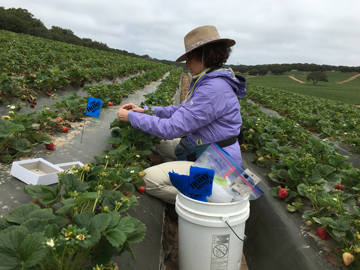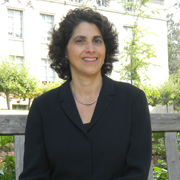When populations of domesticated honeybees began declining in the late 1990s, researchers wondered why. Even today, the phenomenon, now coined “colony collapse disorder”—in which sickly worker bees abandon the queen and her young and flee the hive—is not fully understood.
Honeybees, whose pollination activities contribute to one of every three bites of food we eat, continue to die at faster rates than they reproduce in many countries, including the United States. But Claire Kremen, a conservation biologist at the University of California, Berkeley and co-director of the Berkeley Food Institute, argues that agriculturalists can protect the pollinators they rely on by shifting the way they farm.
Kremen has worked with farmers for nearly two decades. Her tactics include planting floral hedgerows around fields to give pollinators a diverse array of nectar to consume, reducing pesticide use, and abandoning the monoculture practice, where farmers cultivate only one crop at a time. Increasing plant diversity and reducing pesticide use fosters honeybees, Kremen says, but these actions also attract native pollinators, which make a significant contribution to global food production.
Kremen traveled to Boston in February for the annual meeting of the American Association for the Advancement of Science. In a symposium titled “Plan Bee: Restoring Pollinators and Crop Pollination Services in Agricultural Landscapes,” she spoke about the factors that influence the domestic and wild pollinators that inhabit agricultural landscapes. Afterward, Kremen gave SciCom’s Sukee Bennett the buzz about bees and their uncertain future.
What sparked your interest in pollinators?
I read an article that talked about how important pollinators are and how they’re in decline, and how we don’t know very much about these declines. It basically just painted this huge research gap. I just thought this is what I should be doing—“Why don’t I study pollinators?”
What did you want to research, exactly?
The first question I had was, “How important is natural habitat around farmland to support pollinators?” And, “How important are native pollinators in crop pollination?” It really wasn’t known.
Since you entered this field in 1998, have you seen a shift in mentality in general toward bees?
Oh, yeah. It’s been huge. I think when colony collapse disorder started making the news in late 2006 and early 2007, that really jump-started what was going on. I’ve seen a huge difference in understanding that there is a problem, and we need to be doing something. Colony collapse disorder studies became more visible to the U.S. government. And certainly the federal strategy on pollinators—which happened much later—was also a really big and important point.
And what is colony collapse disorder?
It’s something that only affects colonies of honeybees. All the workers just disappear. But the queen and her brood stays in the hive. That’s really weird because in the past when there were big bee die-offs—from pesticides, for example— the bees would be at the doorstep of the hive. They would die right there. But now they just clear. And it does lead to the collapse of the colony, because without workers, the brood can’t get fed.
That’s really sad.
And it’s mysterious—where did those bees go? As we understand colony collapse disorder more and more, it seems to be a complex of things that involve pesticides and their direct effects on bees, and also what we call their sub-lethal effects. There are certain pesticides that change the behavior of the bees when they go out to forage. They might have difficulty foraging or turning because it affects their navigation. We’re also learning more and more that many pesticides are suppressing the immune systems of the bees, and that there are quite a lot of diseases—which is another piece of this—that honeybees are experiencing.
Like mites?
Well, the mites are a problem. The mites weaken the bees by sucking their blood, but they also transmit diseases. Then there are all these pesticides, which are even getting into the hive. They’re in the wax. They’re everywhere. And another piece is their nutrition. It’s too limited when honeybees are placed on a monoculture crop. It’s basically like you having to eat only grapes. You wouldn’t do very well if you only ate grapes.
No, probably not! [Laughter]
Or only almonds. Almonds are great in small quantities, but not in large ones. It’s the same for honeybees. They just don’t do as well when they don’t have a diverse diet. So all these things are interacting and causing problems, and potentially leading to colony collapse.
It sounds like death by a thousand cuts.
Exactly.
But from what you said during your session, it seems like California’s farmers are receptive to making an effort to support bees and other pollinators.
Well, I wish I could say it was really popular among farmers. I’m not sure that’s totally true. I think that there’s a general public awareness about pollinators, and that certainly more farmers are also aware. But as far as doing something about it on their land—I haven’t seen a huge uptake.
But I think we have two broad categories of farmers that would be interested. One sort grows pollinator-dependent crops and recognizes there is a problem. They may have had difficulty getting honeybees for their crops and they want to do something to support wild pollinators on their farm so they’ll have a backup plan. They may also be aware that supporting native pollinators also helps to support honeybees. The other would be a farmer who’s interested in promoting environmental benefits. And I think there are a few farmers that are doing that. So they might not be growing pollinator-dependent crops themselves, but they’re interested in being good stewards of the land.
"It’s too limited when honeybees are placed on a monoculture crop. It’s basically like you having to eat only grapes."
That’s awesome.
Yeah. We do have people in both those categories, but I don’t think it’s the majority of farmers by any means.
So, why do you think there’s a lack of receptivity?
I think it’s because farmers are pulled in so many directions. Pollinators are only one of the many things they have to worry about. If they’re not growing a pollinator-dependent crop, they’re probably not going to be very concerned. They have to deal with labor and regulations, and they have to make sure their crop gets in the ground. So I think that for many farmers, it’s one extra thing that they just can’t handle.
And based on your session, you need to have government support; the government is largely responsible for how we farm. So what do you think is going to happen with the current political climate?
I don’t know if the current political climate will translate into the management decisions that farmers make. To be honest, I think what farmers are most worried about at the moment is where they’re going to get their labor, because in California, they have relied extensively on undocumented immigrants. They are really concerned about that. That’s going to be their biggest problem.
It’s a huge issue.
Yeah, it is. If any farmers would want to do additional things to help pollinators, they might just find that impossible. A lot will depend as well on the Farm Bill. What will be the changes and tweaks in it? What monies will be appropriated? That will really depend on Congress and the committee that determines Farm Bill appropriations.
Do bees tend to slide under the table and get ignored?
No. In 2008, pollinators got mentioned in the Farm Bill for the first time. The National Academy of Sciences study on pollinators, which a national panel put [its] stamp on, was a really important piece. I was a member of the panel. We amassed all the evidence there was about honeybee declines and about native bee declines, and their importance to the economy, and that was done at the end of 2006. It was ironic timing. I think two weeks after it came out, the first reports of colony collapse disorder came out as well.
Wow!
Yeah. Organizations like the North American Pollinator Protection Campaign had a lot of leverage on the next Farm Bill. The subsequent Farm Bill got strengthened even more, and a number of different states put in provisions for pollinators. California did. And that was important to bees.
If we can’t rely on the federal government to protect bees in the future, are there things people can do on a local scale?
Absolutely! There are huge numbers of things people can do, from planting native flowers in their backyard to not using pesticides. People don’t need to use pesticides in their own yard.
Why not?
It’s just unnecessary. One can create a diverse environment that harbors beneficial insects. If you do have a pest outbreak and have to use something, you could use an organic pest control, like Safe Zone, or certain mineral oils. People can really do a lot without using pesticides. And that can really help bees.
There’s a lot we can do at the local level, at the state level, without even requiring a federal strategy. But the fact that we even have a federal strategy is really awesome. I never thought we’d have one. Since 1998, when I first started studying the issue, there’s been a tremendous growth in interest. It’s cool that we do have policies to support it.
____________________
© 2017 Sukee Bennett. Sukee’s stories have colonized the web at sukee.net.


